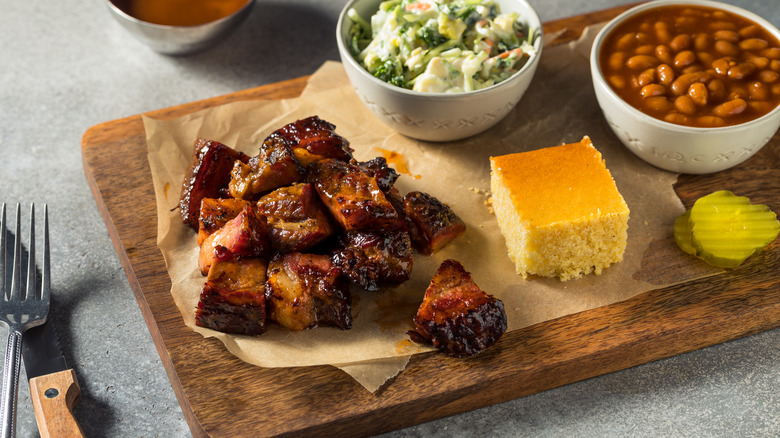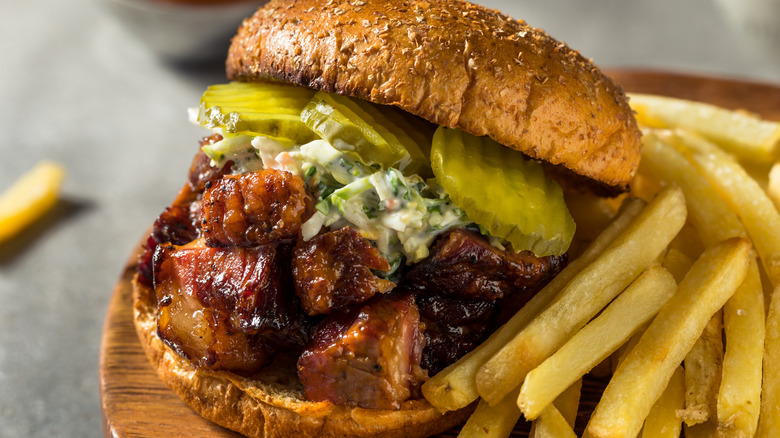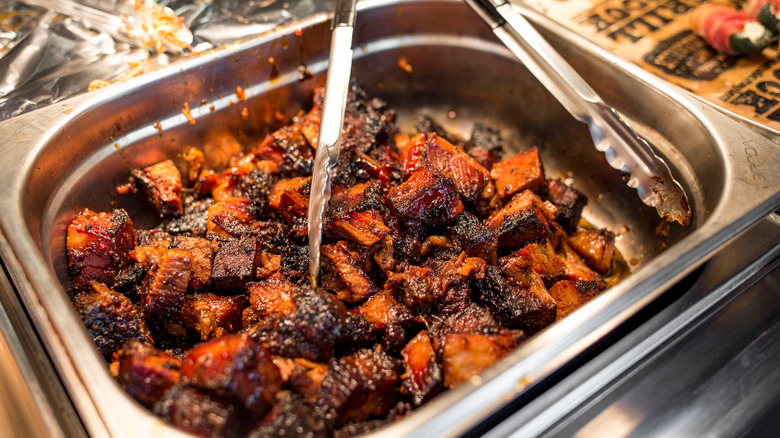What Are The Main Differences Between Brisket And Pork Belly Burnt Ends?
BBQ is one of America's signature dishes, a riotous explosion of flavors that truly sets American cuisine apart since there's nothing quite like it anywhere else in the world. There are all sorts of classic BBQ dishes — pulled pork, beef ribs, and the king of all BBQ meats, brisket, to name just a few — but one of the more underrated has a less-than-appetizing name: burnt ends. Essentially small, cubed BBQ nuggets, burnt ends are known for both their flavor and the crispy texture the smoking process bestows on them.
Here's the thing, though: there isn't just one kind of burnt ends. You've got two main varieties of the dish: brisket burnt ends and pork belly burnt ends. While they share a name and a shape, though, they don't share much else. There are a number of differences between the two which are important to get into, but they start with one very simple and obvious one: brisket burnt ends and pork belly burnt ends aren't even from the same animal.
Brisket is beef, while pork belly is ... well, pork
This sounds obvious, but it does bear repeating: brisket is beef, meaning it comes from a cow. Pork belly, meanwhile, is pork (it's right there in the name), so it's a pig product. So you've immediately got one huge separation right there, as pork is white meat, while beef is red meat, and the two taste virtually nothing alike. But the differences go beyond simply which animal they come from.
It's probably easier just to list their similarities: They're both nuggets made as part of the smoking process, creating a thick bark and giving them a crispy exterior (but a fatty, buttery interior), then covered in BBQ sauce. Neither is actually "burnt" per se — that bark is actually a desirable thing in smoking and doesn't taste like bitter carbonized meat — but their appearance looks like it. But while you can use both in similar ways (they can each be put on a bun and made into a sandwich, for example), they don't taste anything alike.
The two taste nothing alike
Brisket burnt ends are far more common; they became popular in the 1970s as the signature dish of Kansas City BBQ and that's what most people think of when they hear the term. They come from the brisket point rather than the flat — the harder part to cook with, since it contains more connective tissue (this is also the reason you should never cook a brisket on high heat). By contrast, pork belly burnt ends are, as the name implies, made with pork belly, which is essentially just really thick-cut bacon. These differences mean the methods for preparation before smoking are obviously very, very different since you're working with totally different cuts of meat. Interestingly, the end product doesn't taste that different.
If you've ever had brisket and bacon, you know there's not much in the way of flavor similarities, though they're certainly both very fatty cuts — but the BBQ sauce significantly bridges the gap here. The addition of slow-cooked BBQ sauce means the tastes actually wind up being more similar than you'd think; they essentially wind up as similar products with different flavor notes underlying them.
Feel free to try both for yourself and see which you prefer. After all, this is BBQ, and there are no wrong answers here.


